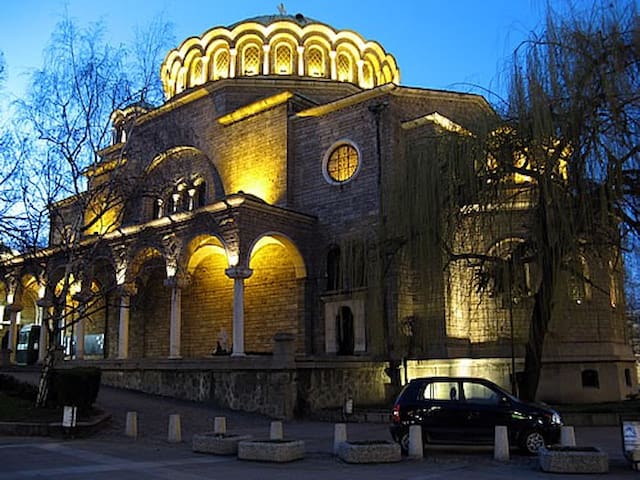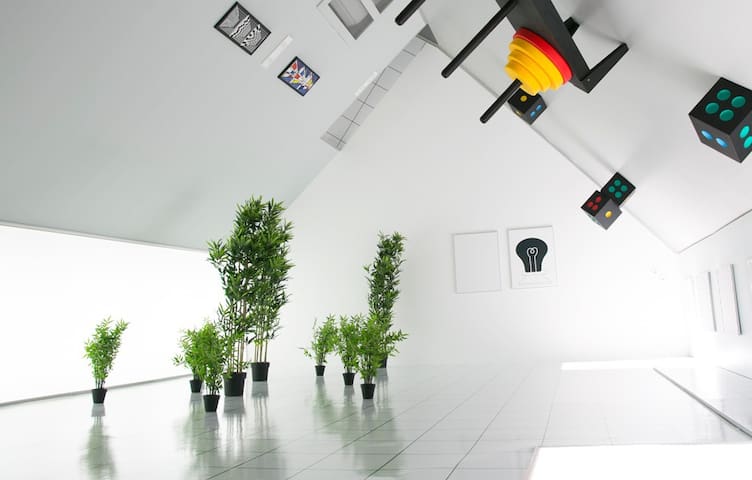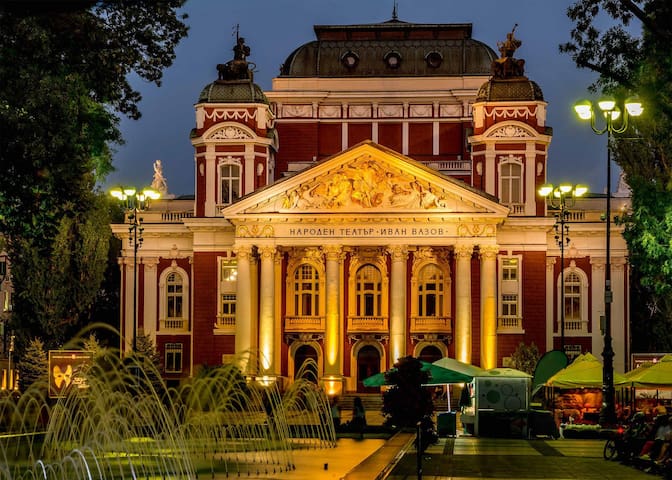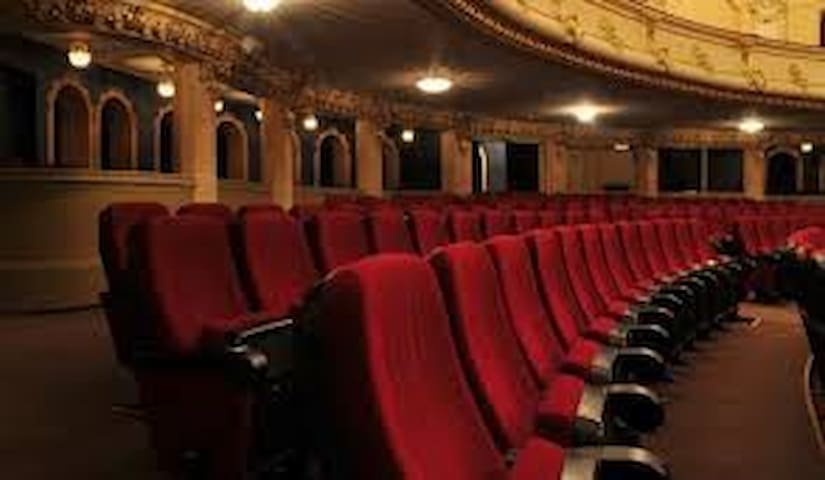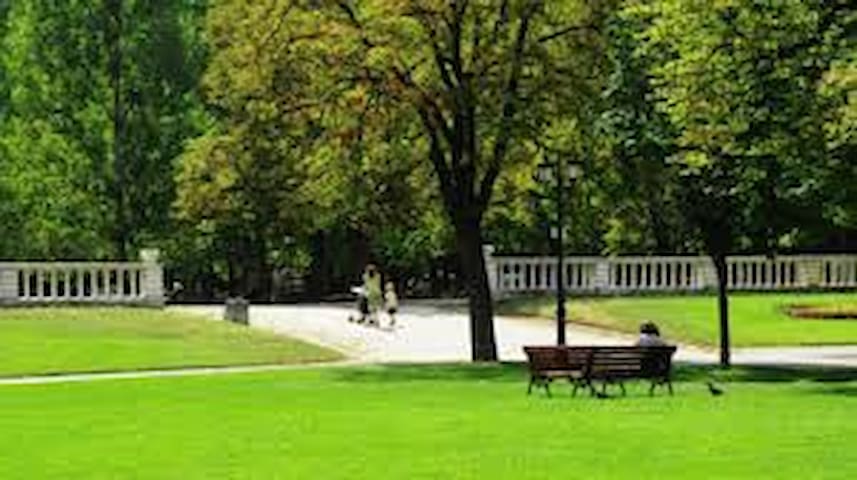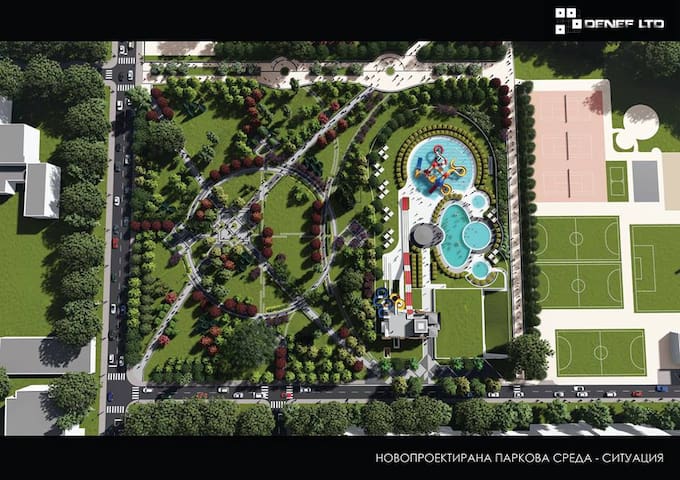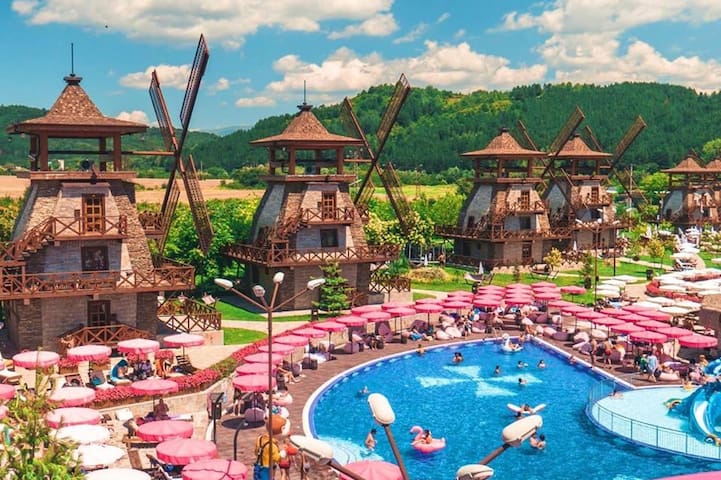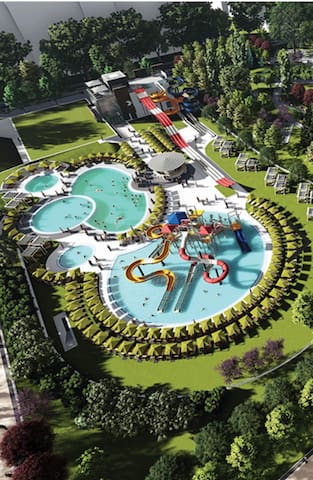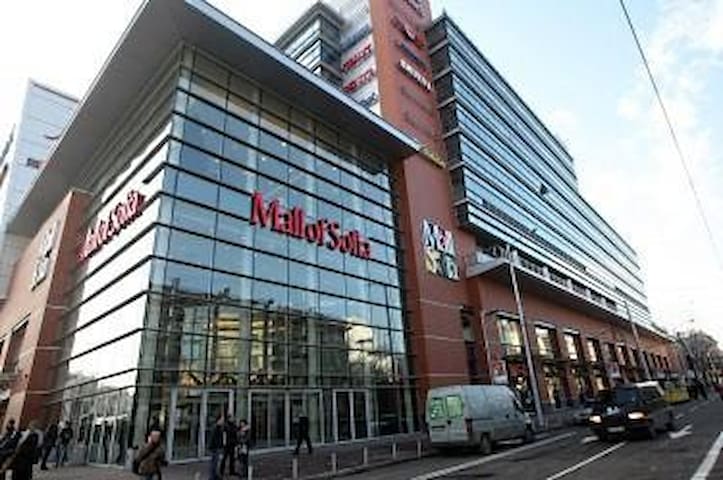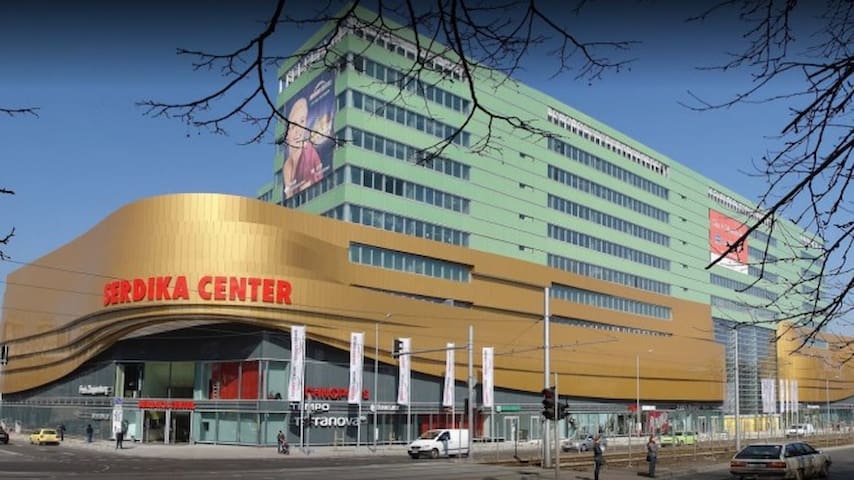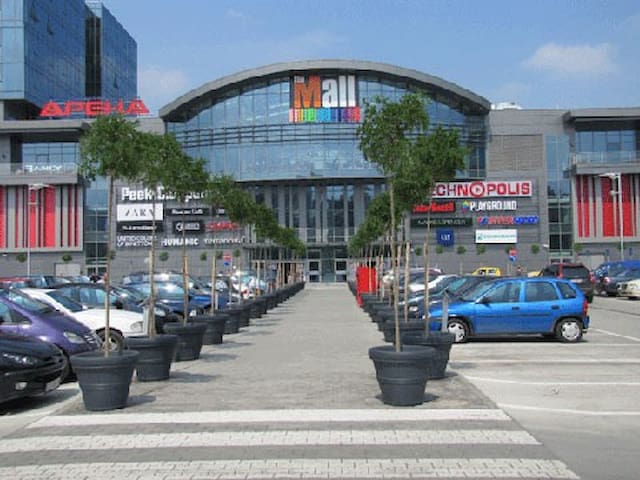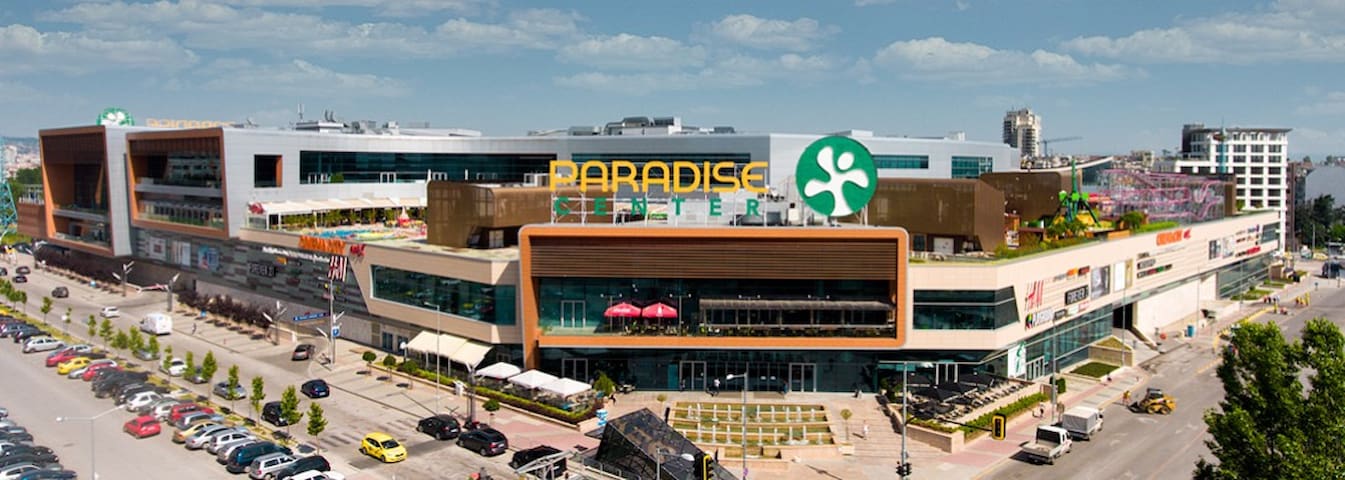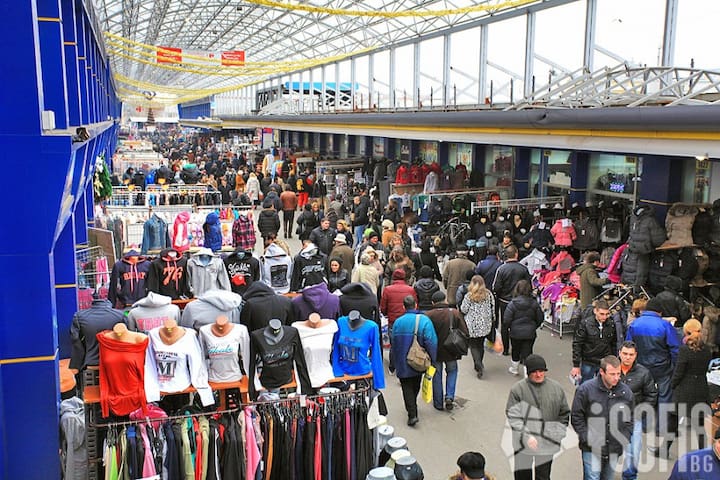Sightseeing
Famous Bulgarian Orthodox Church with neo-Byzantine architecture and underground museum.
St. Alexander Nevski is an Orthodox monument in the city of Sofia, Bulgaria, which is a cathedral of the Bulgarian Patriarch. The church was built in 1882 - 1912 and in 1955 was declared a cultural monument of national importance. Around the cathedral is a square of the same name.
369 명의 현지인이 추천하는 곳
세인트 알렉산더 네브스키 대성당
ploshtad "Sveti Aleksandar Nevski"Famous Bulgarian Orthodox Church with neo-Byzantine architecture and underground museum.
St. Alexander Nevski is an Orthodox monument in the city of Sofia, Bulgaria, which is a cathedral of the Bulgarian Patriarch. The church was built in 1882 - 1912 and in 1955 was declared a cultural monument of national importance. Around the cathedral is a square of the same name.
Russian Orthodox Church.
Its construction began at the end of the 19th century (the exact date is unknown, as different architectural projects alternate), and lasted for many years, consecrated in 1914 on the eve of World War I. The building was built on a plot of the Russian Embassy designed by Mikhail Preobrazhensky specifically for the needs of Russian immigrants in the capital. The murals are the work of a team of artists headed by Vasily Perminov (one of the authors of the murals in Alexander Nevski). The five small domes of the church are gilded. The central dome is 19 m high. The bells were donated by Russian Tsar Nicholas II.
Initially conceived as a chapel to the Russian Embassy in Bulgaria, the temple almost immediately lost its role after 1917. After the Second Russian Revolution, priests and bishops of the so-called "Russian Abroad Church" began to serve in it, and the already established temple became the center of numerous Russian immigration in the country.
After 1947, the temple was transferred to the diocese of the Moscow Patriarchate, which governs it to this day. (It is considered patriarchy or Stavropiy of this patriarchate).
In terms of architecture, the temple was built in the traditions of Russian church architecture from the 19th century - with preserved ancient Russian elements - the so-called "bulbs" (cubes), combined with traditional Old Russian mosaics and woodcarvings, it also bears the marks of more modern architecture and painting. Characteristic of the plan of the temple is the non-axial position of the entrance (the narthex), relative to the altar. Ie the entrance is on the south side, and the altar, according to ancient tradition, points to the east - the two elements form a right angle.
In the crypt of the temple is the tomb of Archbishop Seraphim Sobolev (St. Seraphim, Archbishop Bogucharski, Sophia Wonderworker). Thousands of believers and unbelievers approach him asking for miraculous help before exams, important decisions in life or in times of illness and need. Often, they record their prayers on paper and put them in a special box next to his grave.
104 명의 현지인이 추천하는 곳
러시아 교회 "스베티 니콜라이 밀리키이스키"
3 bul. "Tsar Osvoboditel"Russian Orthodox Church.
Its construction began at the end of the 19th century (the exact date is unknown, as different architectural projects alternate), and lasted for many years, consecrated in 1914 on the eve of World War I. The building was built on a plot of the Russian Embassy designed by Mikhail Preobrazhensky specifically for the needs of Russian immigrants in the capital. The murals are the work of a team of artists headed by Vasily Perminov (one of the authors of the murals in Alexander Nevski). The five small domes of the church are gilded. The central dome is 19 m high. The bells were donated by Russian Tsar Nicholas II.
Initially conceived as a chapel to the Russian Embassy in Bulgaria, the temple almost immediately lost its role after 1917. After the Second Russian Revolution, priests and bishops of the so-called "Russian Abroad Church" began to serve in it, and the already established temple became the center of numerous Russian immigration in the country.
After 1947, the temple was transferred to the diocese of the Moscow Patriarchate, which governs it to this day. (It is considered patriarchy or Stavropiy of this patriarchate).
In terms of architecture, the temple was built in the traditions of Russian church architecture from the 19th century - with preserved ancient Russian elements - the so-called "bulbs" (cubes), combined with traditional Old Russian mosaics and woodcarvings, it also bears the marks of more modern architecture and painting. Characteristic of the plan of the temple is the non-axial position of the entrance (the narthex), relative to the altar. Ie the entrance is on the south side, and the altar, according to ancient tradition, points to the east - the two elements form a right angle.
In the crypt of the temple is the tomb of Archbishop Seraphim Sobolev (St. Seraphim, Archbishop Bogucharski, Sophia Wonderworker). Thousands of believers and unbelievers approach him asking for miraculous help before exams, important decisions in life or in times of illness and need. Often, they record their prayers on paper and put them in a special box next to his grave.
The Church of Saint George (Bulgarian: Ротонда „Свети Георги“ Rotonda "Sveti Georgi") is an Early Christian red brick rotunda that is considered the oldest building in Sofia, the capital of Bulgaria.[1] It is situated behind the Sheraton Hotel, amid remains of the ancient town of Serdica.
Built by the Romans in the 4th century, it is a cylindrical domed structure built on a square base. It is believed that it was built on the site of a pagan temple, though the original purpose of the building was for public use. The building is famous for the 12th-, 13th- and 14th-century frescoes inside the central dome. Three layers of frescoes have been discovered, the earliest dating back to the 10th century. Magnificent frescoes of 22 prophets over 2 metres tall crown the dome. Painted over during the Ottoman period, when the building was used as a mosque, these frescoes were only uncovered and restored in the 20th century.
History and architecture
The church is located in the courtyard between the Sheraton Hotel and the Presidency at a level a few metres below the modern streets of the capital. It is considered to be the oldest preserved building in the city, built at a time when Sofia was the residence of the emperors Galerius and Constantine the Great.
The church is part of a larger archaeological complex. Behind the apse, there are ancient ruins: a section of a Roman street with preserved drainage, foundations of a large basilica, probably a public building, and some smaller buildings. One of the buildings had been equipped with hypocaust and the tiles lifting the floor can be seen today. Experts define it as one of the most beautiful buildings in the so-called "Constantine district" of Serdika-Sredets, where the palace of Emperor Constantine the Great, and later of Sebastokrator Kaloyan were situated. Having survived the trials of time and having kept its appearance almost untouched, it is assumed that some of the most important meetings of the Serdica Ecumenical Council had taken place in the church.
The Rotunda is a part of a large complex of ancient buildings from the late 3rd and early 4th century. It was built of red bricks and has a complex symmetry. At the centre, there is a domed rotunda room with a circular plan on a square base with semicircular niches in the corners. Since the 4th century, it has been used for christening (baptising) ceremonies. The dome rises to 13.70 m from the floor. Through the centuries it had been used as a public, religious and even a representative building.
There are five layers of partially preserved frescoes on the walls: the oldest is a Roman-Byzantine with floral motifs from the 4th century; the second in Bulgarian medieval style with angels from the 10th century; the third from the 11th and 12th centuries – a frieze with prophets and frescoes depicting the Ascension, Assumption, etc.; the fourth is from the 14th century with a donor's portrait of a bishop north of the entrance, and the fifth with Islamic ornamental motifs.
Outstanding among all the murals is the one from the 10th century, created most probably during the reign of the emperors Simeon I the Great, Peter I and Samuil. The soulful human face of an angel, painted under the dome, is unique and one of the most influential examples of the high mastership of Bulgarian artistic school of the golden age of the First Bulgarian Empire.
In the church, there were kept the holy relics of the patron saint of Bulgaria - John of Rila and, according to the legend, they were used to cure the Byzantine Emperor Manuel Comnenus. The relics were taken by the Hungarians in 1183, during the reign of Béla III, when allied Serbs and Magyar troops invaded, destroyed and looted the city.
After a short stay in the capital Esztergom, where the Catholic bishop lost his ability to talk after an indecent act with the relics, they were returned to the recently restored Bulgarian Empire in 1187. The relics of the saint rested here again when they were solemnly carried from the then-capital Tarnovo to the Rila Monastery in 1469. At first, here was buried the Serbian king Stefan Milutin, himself beatified, whose relics were later transferred to the Church of St. King (today, the Sveta Nedelya Church).
During the Ottoman rule in the 16th century, the church became a mosque. In the middle of the 19th century, the Rotunda, along with the Saint Sofia Church and the Sofia Mosque (today National Archaeological Museum) was abandoned by the Muslims. Not long later, the Bulgarians reclaimed its original purpose of a Christian church.
Despite its small size, the church is similar to the rotunda Rotunda of Thessaloniki in Thessaloniki. Carrying the spirit of the early Christian era and Bulgarian medieval culture, St. George has a huge cultural impact. It is subject to extensive research and legitimate interest not only among the Orthodox and Catholic church communities and prominent science and culture figures, but it attracts many pilgrims and ordinary tourists.
In exceptional occasions, the church is used as a setting for solemn military ceremonies and concerts with Orthodox and classical music.
74 명의 현지인이 추천하는 곳
세인트 조지 회전교회
2 bul. Kniaz Aleksandar DondukovThe Church of Saint George (Bulgarian: Ротонда „Свети Георги“ Rotonda "Sveti Georgi") is an Early Christian red brick rotunda that is considered the oldest building in Sofia, the capital of Bulgaria.[1] It is situated behind the Sheraton Hotel, amid remains of the ancient town of Serdica.
Built by the Romans in the 4th century, it is a cylindrical domed structure built on a square base. It is believed that it was built on the site of a pagan temple, though the original purpose of the building was for public use. The building is famous for the 12th-, 13th- and 14th-century frescoes inside the central dome. Three layers of frescoes have been discovered, the earliest dating back to the 10th century. Magnificent frescoes of 22 prophets over 2 metres tall crown the dome. Painted over during the Ottoman period, when the building was used as a mosque, these frescoes were only uncovered and restored in the 20th century.
History and architecture
The church is located in the courtyard between the Sheraton Hotel and the Presidency at a level a few metres below the modern streets of the capital. It is considered to be the oldest preserved building in the city, built at a time when Sofia was the residence of the emperors Galerius and Constantine the Great.
The church is part of a larger archaeological complex. Behind the apse, there are ancient ruins: a section of a Roman street with preserved drainage, foundations of a large basilica, probably a public building, and some smaller buildings. One of the buildings had been equipped with hypocaust and the tiles lifting the floor can be seen today. Experts define it as one of the most beautiful buildings in the so-called "Constantine district" of Serdika-Sredets, where the palace of Emperor Constantine the Great, and later of Sebastokrator Kaloyan were situated. Having survived the trials of time and having kept its appearance almost untouched, it is assumed that some of the most important meetings of the Serdica Ecumenical Council had taken place in the church.
The Rotunda is a part of a large complex of ancient buildings from the late 3rd and early 4th century. It was built of red bricks and has a complex symmetry. At the centre, there is a domed rotunda room with a circular plan on a square base with semicircular niches in the corners. Since the 4th century, it has been used for christening (baptising) ceremonies. The dome rises to 13.70 m from the floor. Through the centuries it had been used as a public, religious and even a representative building.
There are five layers of partially preserved frescoes on the walls: the oldest is a Roman-Byzantine with floral motifs from the 4th century; the second in Bulgarian medieval style with angels from the 10th century; the third from the 11th and 12th centuries – a frieze with prophets and frescoes depicting the Ascension, Assumption, etc.; the fourth is from the 14th century with a donor's portrait of a bishop north of the entrance, and the fifth with Islamic ornamental motifs.
Outstanding among all the murals is the one from the 10th century, created most probably during the reign of the emperors Simeon I the Great, Peter I and Samuil. The soulful human face of an angel, painted under the dome, is unique and one of the most influential examples of the high mastership of Bulgarian artistic school of the golden age of the First Bulgarian Empire.
In the church, there were kept the holy relics of the patron saint of Bulgaria - John of Rila and, according to the legend, they were used to cure the Byzantine Emperor Manuel Comnenus. The relics were taken by the Hungarians in 1183, during the reign of Béla III, when allied Serbs and Magyar troops invaded, destroyed and looted the city.
After a short stay in the capital Esztergom, where the Catholic bishop lost his ability to talk after an indecent act with the relics, they were returned to the recently restored Bulgarian Empire in 1187. The relics of the saint rested here again when they were solemnly carried from the then-capital Tarnovo to the Rila Monastery in 1469. At first, here was buried the Serbian king Stefan Milutin, himself beatified, whose relics were later transferred to the Church of St. King (today, the Sveta Nedelya Church).
During the Ottoman rule in the 16th century, the church became a mosque. In the middle of the 19th century, the Rotunda, along with the Saint Sofia Church and the Sofia Mosque (today National Archaeological Museum) was abandoned by the Muslims. Not long later, the Bulgarians reclaimed its original purpose of a Christian church.
Despite its small size, the church is similar to the rotunda Rotunda of Thessaloniki in Thessaloniki. Carrying the spirit of the early Christian era and Bulgarian medieval culture, St. George has a huge cultural impact. It is subject to extensive research and legitimate interest not only among the Orthodox and Catholic church communities and prominent science and culture figures, but it attracts many pilgrims and ordinary tourists.
In exceptional occasions, the church is used as a setting for solemn military ceremonies and concerts with Orthodox and classical music.
History
The crypt of the church is a Roman tomb (crypt) from the IV century, which means that there was a previous ceremonial building. In the 11th century, the present temple was erected on the crypt. The oldest preserved murals are from the fourteenth century, and above them there is a layer from the fifteenth and sixteenth centuries, by Pimen Zografski. The church is called Petka Iconium, which is the patron saint of the Samargians, whose neighborhood was located in the area during the Middle Ages, and the church was maintained and maintained.
Architecture
The church is a small one-nave structure partly dug into the ground. The walls of the church are 1 m thick, made of bricks and stones. The iconostasis in the church is the work of Debar masters of the Philip family. [1] Some of the icons are from another Deborah master Alexo Vassilev. [2]
The church was restored and exhibited in the 1970s by a project of Arch. N. Mushanov and Arch. Evil. Kirov. The murals were restored by the artist - restorer L. Delchev.
The writer Nikolay Haytov hypothesises that Vasil Levski is buried in the church. The reasons for these claims are controversial interpretations of the results of the archaeological excavations conducted in 1956 and some information in the press of 1937, retelling the stories of the descendants of the perpetrators. In the 1980s, a sharp controversy developed over the issue, but a final decision was not reached due to the contrary opinion of the Archeological Institute and the unanimous opinion was not adopted at the Bulgarian Academy of Sciences. In the 1990s, a marble plaque was placed on the temple with the text saying that "according to the people's memory, V. Levski was buried", which later disappeared. On 18 February 2012. [3] by a decision of the Sofia City Council taken at the suggestion of Angel Dzhambazki, Willie Lilkov and others, a plaque with an inscription was solemnly illuminated east of the apse in front of the church: “According to the national memory and a number of scientific data, patriotic Bulgarians buried in the altar of this church 1873 The Apostle of Freedom Vasil Levski Herodyacus Ignatius The addition of "a number of scientific data" contradicts the decision of the Sofia City Council.
31 명의 현지인이 추천하는 곳
Sveta Petka
History
The crypt of the church is a Roman tomb (crypt) from the IV century, which means that there was a previous ceremonial building. In the 11th century, the present temple was erected on the crypt. The oldest preserved murals are from the fourteenth century, and above them there is a layer from the fifteenth and sixteenth centuries, by Pimen Zografski. The church is called Petka Iconium, which is the patron saint of the Samargians, whose neighborhood was located in the area during the Middle Ages, and the church was maintained and maintained.
Architecture
The church is a small one-nave structure partly dug into the ground. The walls of the church are 1 m thick, made of bricks and stones. The iconostasis in the church is the work of Debar masters of the Philip family. [1] Some of the icons are from another Deborah master Alexo Vassilev. [2]
The church was restored and exhibited in the 1970s by a project of Arch. N. Mushanov and Arch. Evil. Kirov. The murals were restored by the artist - restorer L. Delchev.
The writer Nikolay Haytov hypothesises that Vasil Levski is buried in the church. The reasons for these claims are controversial interpretations of the results of the archaeological excavations conducted in 1956 and some information in the press of 1937, retelling the stories of the descendants of the perpetrators. In the 1980s, a sharp controversy developed over the issue, but a final decision was not reached due to the contrary opinion of the Archeological Institute and the unanimous opinion was not adopted at the Bulgarian Academy of Sciences. In the 1990s, a marble plaque was placed on the temple with the text saying that "according to the people's memory, V. Levski was buried", which later disappeared. On 18 February 2012. [3] by a decision of the Sofia City Council taken at the suggestion of Angel Dzhambazki, Willie Lilkov and others, a plaque with an inscription was solemnly illuminated east of the apse in front of the church: “According to the national memory and a number of scientific data, patriotic Bulgarians buried in the altar of this church 1873 The Apostle of Freedom Vasil Levski Herodyacus Ignatius The addition of "a number of scientific data" contradicts the decision of the Sofia City Council.
It was built on the initiative and with the financial support of the benefactor Mall Efendi Kad Seyfulllah. Therefore, in some sources, the mosque is also referred to as the Molla Effendi Mosque or as the Kad Seyfulllah. On the arch above the door on the stone with paint is written text that cannot be read. Below it is the date 974, which gives reason to believe that it was built in 974 by the Hijra (Muslim yearbook) or 1566-1567.
Architecture
The mosque's main building is quadrangular. Among the four corner cubes are the central cubes and the minaret. In front of it there is an annex (tetim) with three small cubes. It was built in memory of the late wife of Qad Seyfulllah Effendi.
Bath bashi mosque in the late 19th century
Bashi mosque bath is an interesting architectural creation that reflects the specifics of Ottoman architectural thought in the 16th century. It was built by the Ottoman architect Sinan. Its walls are made of carved stone and bricks, with rows of red bricks placed between the stone rows. At the four corners, as in the Makbul Ibrahim Pasha mosque in Razgrad, small towers are erected, under which support structures are lowered through hoops. At the corners of the sixteen beam hoops are placed double breastplates. The walls of the prayer hall and the arches are of stone. The columns are made of a single stone body and are matte. Crowns are double rows of stalacmid. The arch above the front door, which ends with a wreath, is also a stone. The central dome is covered with lead plates. The minaret of the mosque is an exquisite architectural work. According to Evliya Chelebi, she is not equal in beauty in Sofia.
The interior of the mosque has acquired its present appearance as a result of several repairs. The last major overhaul was made in the 1920s with the financial support of Turkish Ambassador to Sofia Fethi Bay. Partial repairs, painting, plastering, etc. were made after World War II. In 1983, a complete restoration of the mosque exterior was carried out, designed by arch. Chr. Ganchev from the National Institute for Cultural Monuments. In recent decades, repairs have been made with donations of Turkish and Arabic waqfs. With their support, an underfloor heating system was built.
The present state of the Banya Bashi mosque gives it the possibility of praying with about 700 Muslims on Friday days and nearly 1,200 Muslims in the Bayrams. The capacity of the mosque is between 500-700 people. That is why during the holidays and Friday prayers, the worshipers pray outside the sidewalk. In the past, mosques of Efendi Qadi Seifulllah and Emin Dede were buried around the mosque.
45 명의 현지인이 추천하는 곳
Banya Bashi Mosque
18 булевард „кн. Мария Луиза“It was built on the initiative and with the financial support of the benefactor Mall Efendi Kad Seyfulllah. Therefore, in some sources, the mosque is also referred to as the Molla Effendi Mosque or as the Kad Seyfulllah. On the arch above the door on the stone with paint is written text that cannot be read. Below it is the date 974, which gives reason to believe that it was built in 974 by the Hijra (Muslim yearbook) or 1566-1567.
Architecture
The mosque's main building is quadrangular. Among the four corner cubes are the central cubes and the minaret. In front of it there is an annex (tetim) with three small cubes. It was built in memory of the late wife of Qad Seyfulllah Effendi.
Bath bashi mosque in the late 19th century
Bashi mosque bath is an interesting architectural creation that reflects the specifics of Ottoman architectural thought in the 16th century. It was built by the Ottoman architect Sinan. Its walls are made of carved stone and bricks, with rows of red bricks placed between the stone rows. At the four corners, as in the Makbul Ibrahim Pasha mosque in Razgrad, small towers are erected, under which support structures are lowered through hoops. At the corners of the sixteen beam hoops are placed double breastplates. The walls of the prayer hall and the arches are of stone. The columns are made of a single stone body and are matte. Crowns are double rows of stalacmid. The arch above the front door, which ends with a wreath, is also a stone. The central dome is covered with lead plates. The minaret of the mosque is an exquisite architectural work. According to Evliya Chelebi, she is not equal in beauty in Sofia.
The interior of the mosque has acquired its present appearance as a result of several repairs. The last major overhaul was made in the 1920s with the financial support of Turkish Ambassador to Sofia Fethi Bay. Partial repairs, painting, plastering, etc. were made after World War II. In 1983, a complete restoration of the mosque exterior was carried out, designed by arch. Chr. Ganchev from the National Institute for Cultural Monuments. In recent decades, repairs have been made with donations of Turkish and Arabic waqfs. With their support, an underfloor heating system was built.
The present state of the Banya Bashi mosque gives it the possibility of praying with about 700 Muslims on Friday days and nearly 1,200 Muslims in the Bayrams. The capacity of the mosque is between 500-700 people. That is why during the holidays and Friday prayers, the worshipers pray outside the sidewalk. In the past, mosques of Efendi Qadi Seifulllah and Emin Dede were buried around the mosque.
The Sofia Synagogue (Bulgarian: Софийска синагога, Sofiyska sinagoga) is the largest synagogue in Southeastern Europe, one of two functioning in Bulgaria (with the other one in Plovdiv) and the third-largest in Europe.[1]
Constructed for the needs of the Bulgarian capital Sofia's mainly Sephardic Jewish community after a project by the Austrian architect Friedrich Grünanger, it resembles the old Moorish Leopoldstädter Tempel in Vienna and was officially opened on 9 September 1909 in the presence of Tsar Ferdinand I of Bulgaria. The first preparations for the synagogue's construction date to 1903, while the construction itself had begun on 13 November 1905. The construction of a grand new synagogue was part of the reorganization efforts of the Bulgarian Jewish community under Lemberg-born Chief Rabbi Marcus Ehrenpreis and local leaders Ezra Tadjer and Avram Davidjon Levy. Prior to the construction of the new synagogue, the lot in central Sofia had been occupied by an older synagogue.
Synagogue interior
One of the architectural monuments of Sofia, the synagogue, located in the very centre of the city near the Central Market Hall, can accommodate 1,300 worshippers. The Sofia Synagogue's main chandelier weighs 1.7 tons and is the largest in the country.
Despite the building's size, the services are normally only attended by some 50 to 60 worshippers due to the aliyah of most of Bulgaria's Jews to Israel and the secularity of the local Jewish population.
The architectural style is essentially Moorish Revival, with elements of the Vienna Secession and, in the facade, Venetian architecture. The main premise has a diameter of 20 m and is 31 m high. It is topped by an octagonal dome. The interior is richly decorated, featuring columns of Carrara marble and multicoloured Venetian mosaics, as well as decorative woodcarving. The entire building takes up 659 m². The biggest chandelier in the Balkans is there and the rumor said it is made from gold from Ancient Palestine.
Since 8 May 1992 the Sofia Synagogue also houses the Jewish Museum of History, which includes the Jewish Communities in Bulgaria and the Holocaust and the Salvation of the Jews in Bulgaria expositions. A souvenir shop is also in operation.
54 명의 현지인이 추천하는 곳
Sofia Synagogue
16 Exarch Joseph StreetThe Sofia Synagogue (Bulgarian: Софийска синагога, Sofiyska sinagoga) is the largest synagogue in Southeastern Europe, one of two functioning in Bulgaria (with the other one in Plovdiv) and the third-largest in Europe.[1]
Constructed for the needs of the Bulgarian capital Sofia's mainly Sephardic Jewish community after a project by the Austrian architect Friedrich Grünanger, it resembles the old Moorish Leopoldstädter Tempel in Vienna and was officially opened on 9 September 1909 in the presence of Tsar Ferdinand I of Bulgaria. The first preparations for the synagogue's construction date to 1903, while the construction itself had begun on 13 November 1905. The construction of a grand new synagogue was part of the reorganization efforts of the Bulgarian Jewish community under Lemberg-born Chief Rabbi Marcus Ehrenpreis and local leaders Ezra Tadjer and Avram Davidjon Levy. Prior to the construction of the new synagogue, the lot in central Sofia had been occupied by an older synagogue.
Synagogue interior
One of the architectural monuments of Sofia, the synagogue, located in the very centre of the city near the Central Market Hall, can accommodate 1,300 worshippers. The Sofia Synagogue's main chandelier weighs 1.7 tons and is the largest in the country.
Despite the building's size, the services are normally only attended by some 50 to 60 worshippers due to the aliyah of most of Bulgaria's Jews to Israel and the secularity of the local Jewish population.
The architectural style is essentially Moorish Revival, with elements of the Vienna Secession and, in the facade, Venetian architecture. The main premise has a diameter of 20 m and is 31 m high. It is topped by an octagonal dome. The interior is richly decorated, featuring columns of Carrara marble and multicoloured Venetian mosaics, as well as decorative woodcarving. The entire building takes up 659 m². The biggest chandelier in the Balkans is there and the rumor said it is made from gold from Ancient Palestine.
Since 8 May 1992 the Sofia Synagogue also houses the Jewish Museum of History, which includes the Jewish Communities in Bulgaria and the Holocaust and the Salvation of the Jews in Bulgaria expositions. A souvenir shop is also in operation.
The Cathedral of St Joseph (Bulgarian: катедрала „Св. Йосиф“) is a Roman Catholic cathedral in Sofia, the capital of Bulgaria. It is the co-cathedral of the Diocese of Sofia and Plovdiv, together with the Cathedral of St Louis in Plovdiv.
The cathedral, rebuilt at its previous location after it was destroyed by Allied bombing raids during World War II, was inaugurated on 21 May 2006 in the presence of Cardinal Secretary of State Angelo Sodano, Dean of the College of Cardinals of the Roman Catholic Church. The foundation stone of the new cathedral was laid personally by Pope John Paul II during his visit to Bulgaria in 2002.
"Saint Joseph" is the largest Catholic cathedral in Bulgaria has 350 seats and can hold up to 1,000 worshipers. The cathedral is 23 metres long, 15 metres wide is, is 19 metres high main body of the building with a roof height of 23 metres and the tower is equipped with four electronically operated bells, is 33 metres high. The cathedral is equipped with body and over the altar stands 7 meter wooden cross of Christ. Under cross is the icon of Mary (mother of Jesus), given by Patriarch Maxim at the dedication of the temple.
On both sides of presbytery are two statues, the patron of St. Joseph Cathedral and Capuchin patron St. Francis of Assisi.
On the right side of the entrance is the icon of God's Mercy with the inscription: "Jesus, I trust to thee." This icon is linked to the devotion to the Divine Mercy and the coming of Jesus into the world Faustina Kowalska. At the entrance is the statue of the Mary (mother of Jesus) in Lourdes in 1858 appeared to St. Bernadette Subiru to be declared as a pure conception. On the other side of the gate of the cathedral are the statues of some of the most popular saints in the Catholic Church - St. Therese of the Child Jesus, Carmelite barefoot and St Anton from Padua Franciscan.
To the fence of the cathedral is a statue of Pope John XXIII, which was consecrated by Pope John Paul II during his visit in 2002 in the parish.
Holy Mass services:
Saturday 6 pm - bulgarian; Sunday 9 am - polish; Sunday 10,30 am - bulgarian; Sunday 12 pm - latin; Sunday 6 pm - bulgarian;
15 명의 현지인이 추천하는 곳
Catholic Cathedral of St Joseph
146 ul. "Knyaz Boris I"The Cathedral of St Joseph (Bulgarian: катедрала „Св. Йосиф“) is a Roman Catholic cathedral in Sofia, the capital of Bulgaria. It is the co-cathedral of the Diocese of Sofia and Plovdiv, together with the Cathedral of St Louis in Plovdiv.
The cathedral, rebuilt at its previous location after it was destroyed by Allied bombing raids during World War II, was inaugurated on 21 May 2006 in the presence of Cardinal Secretary of State Angelo Sodano, Dean of the College of Cardinals of the Roman Catholic Church. The foundation stone of the new cathedral was laid personally by Pope John Paul II during his visit to Bulgaria in 2002.
"Saint Joseph" is the largest Catholic cathedral in Bulgaria has 350 seats and can hold up to 1,000 worshipers. The cathedral is 23 metres long, 15 metres wide is, is 19 metres high main body of the building with a roof height of 23 metres and the tower is equipped with four electronically operated bells, is 33 metres high. The cathedral is equipped with body and over the altar stands 7 meter wooden cross of Christ. Under cross is the icon of Mary (mother of Jesus), given by Patriarch Maxim at the dedication of the temple.
On both sides of presbytery are two statues, the patron of St. Joseph Cathedral and Capuchin patron St. Francis of Assisi.
On the right side of the entrance is the icon of God's Mercy with the inscription: "Jesus, I trust to thee." This icon is linked to the devotion to the Divine Mercy and the coming of Jesus into the world Faustina Kowalska. At the entrance is the statue of the Mary (mother of Jesus) in Lourdes in 1858 appeared to St. Bernadette Subiru to be declared as a pure conception. On the other side of the gate of the cathedral are the statues of some of the most popular saints in the Catholic Church - St. Therese of the Child Jesus, Carmelite barefoot and St Anton from Padua Franciscan.
To the fence of the cathedral is a statue of Pope John XXIII, which was consecrated by Pope John Paul II during his visit in 2002 in the parish.
Holy Mass services:
Saturday 6 pm - bulgarian; Sunday 9 am - polish; Sunday 10,30 am - bulgarian; Sunday 12 pm - latin; Sunday 6 pm - bulgarian;
Sveta Nedelya Church (Bulgarian: Катедрален храм "Св. великомъченица Неделя" в София or църква „Света Неделя“, romanized: Sveta Nedelya) is an Eastern Orthodox church in Sofia, the capital of Bulgaria, a cathedral of the Sofia bishopric of the Bulgarian Patriarchate. Sveta Nedelya is a medieval church that has suffered destruction through the ages and has been reconstructed many times. The present building of the temple is among the landmarks of Sofia. It was designed by the famous Bulgarian architectural team Vasilyov-Tsolov.
History
The history of the cathedral's earliest years is to a large extent unknown. It was probably built in the 10th century and had stone foundations and an otherwise wooden construction, remaining wooden until the middle of the 19th century, unlike most other churches in the city. A German traveller by the name of Stephan Gerlach visited Sofia in 1578 and mentioned the church.
Around 1460, the remains of Serbian king Stefan Milutin were carried to Bulgaria and were stored in various churches and monasteries until being transferred to St Nedelya after it became a bishop's residence in the 18th century. With some interruptions, the remains have been preserved in the church ever since and the church acquired another name, Holy King („Свети Крал“, „Sveti Kral“), in the late 19th and early 20th century.
The former building was demolished to make place for a larger and more imposing cathedral on 25 April 1856. The construction of the 35.5 m-long and 19 m-wide church began in the summer of the same year. The still incomplete building suffered from an earthquake in 1858, which prolonged the construction works that ultimately finished in 1863. It was officially inaugurated on 11 May 1867 in the presence of 20,000 people. A new belfry was erected to accommodate the 8 bells given to the church as a present by Russian Knyaz (Prince) Alexander Mikhailovich Dondukov-Korsakov in 1879.
The church was renovated in 1898, with new domes being added. Exarch Joseph I of Bulgaria was buried immediately outside the walls of St Nedelya in 1915. The church was razed in the assault in 1925 that claimed over 150 victims. After the assault, the church was restored to its modern appearance between the summer of 1927 and the spring of 1933 (once again inaugurated on 7 April 1933). It was almost erected anew as a temple 30 m in length and 15.50 m in width and featuring a central dome that made it 31 m high. The gilt iconostasis that survived the bomb attack was returned to the church.
The mural decoration was done by a team led by Nikolay Rostovtsev between 1971 and 1973. The floor was renovated and the north colonnade was glazed between 1992 and 1994. The façade was cleaned thoroughly in 2000 and a device to automatically ring the eleven bells (the eight ones from Knyaz Dondukov-Korsakov, two made in Serbia and one cast in Bulgaria)
Name
The origin of the name Sveta Nedelya is rather obscure. It can be translated as either "Holy Sunday", "Saint Nedelya", or even as "Saint Sunday", depending on which etymology is taken as the basis. According to the Bulgarian Orthodox website pravoslavieto.com, the church was noted by a German traveller, Stephan Gerlach, in 1578, as being known by several names, among which "The Lord's Church" (Bulgarian: Gospodnya Tsurkva) and "Jesus Christ Church" (Tsurkva Isus Hristos) but, more importantly, by the Greek name Kyriaki,[1] a word literally meaning "Sunday", but which itself derives from Kyrios – "Lord" (i.e. Sunday, or Kyriaki = "The Lord's Day" and hence "The Lord's Church"). Furthermore, Kyriaki is also the name of a third-century Christian martyr – Saint Kyriaki, known in Bulgarian as Sveta Nedelya (Nedelya = "Sunday"). So, even though today the meaning appears to refer to the holiness of the day of Sunday, it may have originally referred to the young martyr Saint Kyriaki, or ultimately to Jesus Christ.
108 명의 현지인이 추천하는 곳
성 키리아키 대성당 교회
20 pl. "Sveta Nedelya"Sveta Nedelya Church (Bulgarian: Катедрален храм "Св. великомъченица Неделя" в София or църква „Света Неделя“, romanized: Sveta Nedelya) is an Eastern Orthodox church in Sofia, the capital of Bulgaria, a cathedral of the Sofia bishopric of the Bulgarian Patriarchate. Sveta Nedelya is a medieval church that has suffered destruction through the ages and has been reconstructed many times. The present building of the temple is among the landmarks of Sofia. It was designed by the famous Bulgarian architectural team Vasilyov-Tsolov.
History
The history of the cathedral's earliest years is to a large extent unknown. It was probably built in the 10th century and had stone foundations and an otherwise wooden construction, remaining wooden until the middle of the 19th century, unlike most other churches in the city. A German traveller by the name of Stephan Gerlach visited Sofia in 1578 and mentioned the church.
Around 1460, the remains of Serbian king Stefan Milutin were carried to Bulgaria and were stored in various churches and monasteries until being transferred to St Nedelya after it became a bishop's residence in the 18th century. With some interruptions, the remains have been preserved in the church ever since and the church acquired another name, Holy King („Свети Крал“, „Sveti Kral“), in the late 19th and early 20th century.
The former building was demolished to make place for a larger and more imposing cathedral on 25 April 1856. The construction of the 35.5 m-long and 19 m-wide church began in the summer of the same year. The still incomplete building suffered from an earthquake in 1858, which prolonged the construction works that ultimately finished in 1863. It was officially inaugurated on 11 May 1867 in the presence of 20,000 people. A new belfry was erected to accommodate the 8 bells given to the church as a present by Russian Knyaz (Prince) Alexander Mikhailovich Dondukov-Korsakov in 1879.
The church was renovated in 1898, with new domes being added. Exarch Joseph I of Bulgaria was buried immediately outside the walls of St Nedelya in 1915. The church was razed in the assault in 1925 that claimed over 150 victims. After the assault, the church was restored to its modern appearance between the summer of 1927 and the spring of 1933 (once again inaugurated on 7 April 1933). It was almost erected anew as a temple 30 m in length and 15.50 m in width and featuring a central dome that made it 31 m high. The gilt iconostasis that survived the bomb attack was returned to the church.
The mural decoration was done by a team led by Nikolay Rostovtsev between 1971 and 1973. The floor was renovated and the north colonnade was glazed between 1992 and 1994. The façade was cleaned thoroughly in 2000 and a device to automatically ring the eleven bells (the eight ones from Knyaz Dondukov-Korsakov, two made in Serbia and one cast in Bulgaria)
Name
The origin of the name Sveta Nedelya is rather obscure. It can be translated as either "Holy Sunday", "Saint Nedelya", or even as "Saint Sunday", depending on which etymology is taken as the basis. According to the Bulgarian Orthodox website pravoslavieto.com, the church was noted by a German traveller, Stephan Gerlach, in 1578, as being known by several names, among which "The Lord's Church" (Bulgarian: Gospodnya Tsurkva) and "Jesus Christ Church" (Tsurkva Isus Hristos) but, more importantly, by the Greek name Kyriaki,[1] a word literally meaning "Sunday", but which itself derives from Kyrios – "Lord" (i.e. Sunday, or Kyriaki = "The Lord's Day" and hence "The Lord's Church"). Furthermore, Kyriaki is also the name of a third-century Christian martyr – Saint Kyriaki, known in Bulgarian as Sveta Nedelya (Nedelya = "Sunday"). So, even though today the meaning appears to refer to the holiness of the day of Sunday, it may have originally referred to the young martyr Saint Kyriaki, or ultimately to Jesus Christ.
History and architecture
The church was built on the site of several earlier churches from 4th c. and places of worship dating back to the days when it was the necropolis of the Roman town of Serdica. In the 2nd century, it was the location of a Roman theatre. Over the next few centuries, several other churches were constructed, only to be destroyed by invading forces such as the Goths and the Huns. The basic cross design of the present basilica, with its two east towers and one tower-cupola, is believed to be the fifth structure to be constructed on the site and was built during the reign of Byzantine Emperor Justinian I in the middle of the 6th century (527-565). It is thus a contemporary of the better-known Hagia Sophia church in Constantinople.
During the Second Bulgarian Empire (spanning the 12th to 14th centuries), the structure acquired the status of a metropolitan church. In the 14th century, the church gave its name to the city. In the 16th century, during Ottoman rule, the church was converted into a mosque: the original 12th-century frescoes were destroyed and minarets were added. In the 19th century two earthquakes destroyed one of the minarets and the mosque was abandoned. Restoration work was begun after 1900.
The Saint Sofia Church is now one of the most valuable pieces of Early Christian architecture in Southeastern Europe. The present building is a cross basilica with three altars. The floor of the church is covered with complex Early Christian ornamental or flora and fauna-themed mosaics. The Saint Sofia Church stands in the middle of an ancient necropolis and many tombs have been unearthed both under and near the church. Some of the tombs even feature frescoes.
Because Saint Sophia represents Holy Wisdom, icons within the church depict Sophia as Christ Emmanuel, a young figure of Christ seated on a rainbow. The church also displays icons of historical saints, including St. George and St. Vladimir.
80 명의 현지인이 추천하는 곳
St. Sophia Church
2 ul. "Paris"History and architecture
The church was built on the site of several earlier churches from 4th c. and places of worship dating back to the days when it was the necropolis of the Roman town of Serdica. In the 2nd century, it was the location of a Roman theatre. Over the next few centuries, several other churches were constructed, only to be destroyed by invading forces such as the Goths and the Huns. The basic cross design of the present basilica, with its two east towers and one tower-cupola, is believed to be the fifth structure to be constructed on the site and was built during the reign of Byzantine Emperor Justinian I in the middle of the 6th century (527-565). It is thus a contemporary of the better-known Hagia Sophia church in Constantinople.
During the Second Bulgarian Empire (spanning the 12th to 14th centuries), the structure acquired the status of a metropolitan church. In the 14th century, the church gave its name to the city. In the 16th century, during Ottoman rule, the church was converted into a mosque: the original 12th-century frescoes were destroyed and minarets were added. In the 19th century two earthquakes destroyed one of the minarets and the mosque was abandoned. Restoration work was begun after 1900.
The Saint Sofia Church is now one of the most valuable pieces of Early Christian architecture in Southeastern Europe. The present building is a cross basilica with three altars. The floor of the church is covered with complex Early Christian ornamental or flora and fauna-themed mosaics. The Saint Sofia Church stands in the middle of an ancient necropolis and many tombs have been unearthed both under and near the church. Some of the tombs even feature frescoes.
Because Saint Sophia represents Holy Wisdom, icons within the church depict Sophia as Christ Emmanuel, a young figure of Christ seated on a rainbow. The church also displays icons of historical saints, including St. George and St. Vladimir.
The Boyana Church (Bulgarian: Боянска църква, Boyanska tsărkva) is a medieval Bulgarian Orthodox church situated on the outskirts of Sofia, the capital of Bulgaria, in the Boyana quarter. In 1979, the building was added to the UNESCO World Heritage List.
The east wing of the two-storey church was originally constructed in the late 10th or early 11th century, then the central wing was added in the 13th century under the Second Bulgarian Empire, the whole building being finished with a further expansion to the west in the middle of the 19th century. A total of 89 scenes with 240 human images are depicted on the walls of the church.
History and architecture
The Boyana Church was built in three stages: in the late 10th to early 11th, the mid-13th, and the mid-19th centuries. The oldest section (the eastern church) is a small one-apse cross-vaulted church with inbuilt cruciform supports. It was built in the late 10th or the early 11th century.
The second section, which adjoins the eastern church, was commissioned by Sebastocrator Kaloyan and his wife Desislava in the mid-13th century. This building belongs to the two-floor tomb-church type. It consists of a ground-floor family sepulchre with a semi-cylindrical vault and two arcosolia on the north and south walls, and of an upper-floor family chapel identical in design to the eastern church. The exterior is decorated with ceramic ornaments.
The last section was built with donations from the local community in the mid-19th century. The church was closed to the public in 1954 in order to be conserved and restored. It was only partially reopened in 2006.
As a protection measure, air-conditioning was installed to keep the temperature at 17–18 degrees Celsius (62–64 Fahrenheit), with low-heat lighting. Groups of up to 8 visitors are permitted to stay for 10 minutes. The building, placed under the management of the National Historical Museum (Bulgaria), was fully reopened to the public by Culture Minister Stefan Danailov on October 2, 2008.
102 명의 현지인이 추천하는 곳
보야나 교회 박물관
3 ul. "Boyansko ezero"The Boyana Church (Bulgarian: Боянска църква, Boyanska tsărkva) is a medieval Bulgarian Orthodox church situated on the outskirts of Sofia, the capital of Bulgaria, in the Boyana quarter. In 1979, the building was added to the UNESCO World Heritage List.
The east wing of the two-storey church was originally constructed in the late 10th or early 11th century, then the central wing was added in the 13th century under the Second Bulgarian Empire, the whole building being finished with a further expansion to the west in the middle of the 19th century. A total of 89 scenes with 240 human images are depicted on the walls of the church.
History and architecture
The Boyana Church was built in three stages: in the late 10th to early 11th, the mid-13th, and the mid-19th centuries. The oldest section (the eastern church) is a small one-apse cross-vaulted church with inbuilt cruciform supports. It was built in the late 10th or the early 11th century.
The second section, which adjoins the eastern church, was commissioned by Sebastocrator Kaloyan and his wife Desislava in the mid-13th century. This building belongs to the two-floor tomb-church type. It consists of a ground-floor family sepulchre with a semi-cylindrical vault and two arcosolia on the north and south walls, and of an upper-floor family chapel identical in design to the eastern church. The exterior is decorated with ceramic ornaments.
The last section was built with donations from the local community in the mid-19th century. The church was closed to the public in 1954 in order to be conserved and restored. It was only partially reopened in 2006.
As a protection measure, air-conditioning was installed to keep the temperature at 17–18 degrees Celsius (62–64 Fahrenheit), with low-heat lighting. Groups of up to 8 visitors are permitted to stay for 10 minutes. The building, placed under the management of the National Historical Museum (Bulgaria), was fully reopened to the public by Culture Minister Stefan Danailov on October 2, 2008.
Museums
국립 공과 기술 박물관
66 ul. "Opalchenska"https://www.polytechnicsofia.com/
Archeological Museum
площад „Атанас Буров“https://www.naim.bg/
National Art Gallery
1 пл. „Княз Александър I“https://nationalgallery.bg/bg/
National Museum of Natural History
1 bul. "Tsar Osvoboditel"http://www.nmnhs.com/index_bg.php
National Museum of History
16 ul. "Vitoshko lale"https://historymuseum.org/
Museum of Sport
Bulevard "Evlogi i Hristo Georgiev"http://www.nsb.bg/bg/
소피아 환영 박물관
16 булевард „кн. Мария Луиза“http://museumofillusions.bg/
소피아 지역 역사 박물관
1 Platno.„Banski"http://www.sofiahistorymuseum.bg/bg/
Free time and fun
소피아 동물원
37-11 ul. "Srebarna"http://zoosofia.eu/
국립문화궁전공원
Bulevard "Bulgaria"http://www.ndk.bg/
이반 바조프 국립극장
5 ul. "Dyakon Ignatiy"https://www.nationaltheatre.bg/bg
Bulgarian Army Theatre
98 ulitsa „Georgi S. Rakovski“http://www.tba.art.bg/
새로운 드라마 극장 소금과 웃음
127 ulitsa „Georgi S. Rakovski“https://www.salzaismyah.bg/
Teatar 199 Valentin Stoychev
8 ul. "Slavyanska"https://theatre199.org/
Playground
100 bulevard "Cherni vrah"South Park
보리소바 그라디나
공원 "성삼위대"
비토샤산
ulitsa "Detski mir"바즈라즈다네 공원
박물관 "브라나" 공원
№ 55 Boulevard "Tsarigradsko shose"http://www.park-vrana.com/
허드로파티 벨라라티 메리스
https://www.melnicite.bg/
Muzeiko
3 ul. "Professor Boyan Kamenov"http://www.muzeiko.bg/bg
CABANA Rooftop Beach Bar
111В Boulevard "Tsarigradsko shose"http://www.cabana-rooftop.com/
Vazrazhdane Aqua Park
https://vazrajdane-wellness.com/
Shopping
소피아 몰
101 A bul. "Aleksandar Stamboliyski"http://mallofsofia.bg/
Serdika Center
48 bul. "Sitnyakovo"https://serdikacenter.bg/
더 몰
115з Boulevard "Tsarigradsko shose"http://themall.bg/
Sofia Outlet Center
92A Boulevard "Tsarigradsko shose"http://www.sofiaoutletcenter.bg/
파라다이스 센터
100 bulevard "Cherni vrah"http://paradise-center.com/bg
Sofia Ring Mall
214 ul. "Okolovrasten pat"http://www.sofiaring.bg/bg
bulevard "Vitosha"
bulevard "Vitosha"Bazaar Iliyantsi
여자 시각
bulevard "Stefan Stambolov"디미타르 페트코프 시장
120Б ul. "Pirotska"Restaurants
Наш'то Място
38-40 ulitsa "Bregalnitsa"https://nashtomiasto.business.site/?utm_source=gmb&utm_medium=referral
Timo Park
ulitsa "Hisarya"https://timopark.com/
Contessa
78 ul. "Pirotska"https://web.facebook.com/pages/Kontesa/189581211087360?_rdc=1&_rdr
Happy Bar & Grill
101 Ulitsa Al. Stamboliyskihttps://happy.bg/
Moskovska 15
15 ul. "Moskovska"http://clock.bky.bg/
Raffy Bar & Gelato
18 bul. "Vitosha"http://www.raffy.bg/
Divaka
41А ul. "6-ti septemvri"http://divaka.bg/
Shtastlivetsa
27 bul. "Vitosha"http://www.shtastliveca.com/
Moma Bulgarian Food and Wine
28 ul. "Solunska"https://moma-restaurant.com/
Ale House
42 ul. "Hristo Belchev"http://www.alehouse.bg/
Franco's Pizza
37 ul. "Han Asparuh"37 Han Asparuh Street, 1000 Center, Sofia
088 640 6666
Largo bar and dinner
2 булевард „кн. Мария Луиза“2, Princess Maria Louisa Blvd., 1000 Sofia Center
088 833 2222
diip bar
15A ul. Lege15A Lege Street, 1000 Center, Sofia
088 645 5155
Sense Hotel Sofia
16 bul. "Tsar Osvoboditel"https://www.sensehotel.com/
Skaptobara
11А ulitsa "Iskar"https://skapto.bg/bg/home/
https://www.victoria.bg/%D1%80%D0%B5%D1%81%D1%82%D0%BE%D1%80%D0%B0%D0%BD%D1%82%D0%B8/%D1%81%D0%BE%D1%84%D0%B8%D1%8F/%D0%BB%D0%BE%D0%B2%D0%B5%D0%BD-%D0%BF%D0%B0%D1%80%D0%BA/
20 명의 현지인이 추천하는 곳
Restaurant Victoria Hunting Park
№1 Boulevard "Simeonovsko Shosehttps://www.victoria.bg/%D1%80%D0%B5%D1%81%D1%82%D0%BE%D1%80%D0%B0%D0%BD%D1%82%D0%B8/%D1%81%D0%BE%D1%84%D0%B8%D1%8F/%D0%BB%D0%BE%D0%B2%D0%B5%D0%BD-%D0%BF%D0%B0%D1%80%D0%BA/
Restaurant Vodenitzata
http://vodenitzata.com/
Brum Bar & Kitchen
33 ul. "Tsar Samuil"http://www.spaghetti-kitchen.bar/

